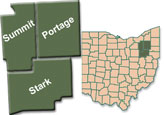

|

|

|

|

|

|

|

|

|

|


|
 |
City of Canton Field Equipment Equipment Packages |
The following equipment packages are associated with the "City of Canton Field Equipment" element. Select the "Details" icon to see the detailed process specifications that support each equipment package, or consult the National ITS Architecture web site for more information.
This equipment package manages highway traffic at highway-rail intersections (HRIs) where operational requirements demand advanced features (e.g., where rail operational speeds are greater than 80 miles per hour). It includes all capabilities from the Standard Rail Crossing equipment package and augments these with additional safety features. The active warning systems supported by this market package includes positive barrier systems which preclude entrance into the intersection when the barriers are activated. Like the Standard package, the HRI equipment is activated on notification by wayside interface equipment which detects, or communicates with the approaching train. In this equipment package, additional information about the arriving train is also provided by the wayside interface equipment so that the train's direction of travel, its estimated time of arrival, and the estimated duration of closure may be derived. This enhanced information may be conveyed to the driver prior to, or in context with, warning system activation. This equipment package also includes detection capabilities which enable it to detect an entrapped or otherwise immobilized vehicle within the HRI and provide an immediate notification to the wayside interface equipment and traffic management.
This equipment package collects traffic, road, and environmental conditions information for use in transportation planning, research, and other off-line applications where data quality and completeness take precedence over real-time performance. This equipment package includes the sensors, supporting roadside infrastructure, and communications equipment that collects and transfers information to a center for archival.
This Equipment package shall provide the capability to receive vehicle signal priority requests and control roadside signals accordingly.
This Equipment package provides the capabilities to monitor traffic flow in major intersections and on main highways for urban areas and to monitor road conditions using fixed equipment such as loop detectors and wireline communication.
Roadway Equipment Coordination
![]()
This equipment package coordinates field equipment that is distributed along the roadway by supporting direct communications between field equipment. This includes coordination between remote sensors and field devices (e.g., Dynamic Message Signs) and coordination between the field devices themselves (e.g., coordination between traffic controllers that are controlling adjacent intersections.).
This Equipment package provides incident detection capability to reside at the roadside. For example, advanced CCTV's with built-in incident detection algorithms would allow the actual detection function to be roadside rather than transmitting images to a center for visual or automated detection.
Roadway Infrastructure Monitoring
![]()
This equipment package monitors the condition of pavement, bridges, tunnels, associated hardware, and other transportation-related infrastructure (e.g., culverts). It includes sensors that monitor the infrastructure and the communications necessary to report this data to a center or vehicle-based maintenance system.
This Equipment package provides the capabilities to control traffic signals at major intersections and on main highways for urban areas. This Equipment package is generally constrained to a single jurisdiction.
Roadway Traffic Information Dissemination
![]()
This Equipment package provides the roadside elements of traffic information dissemination including DMS, HAR, and talking pedestrian signs.
Roadway Work Zone Traffic Control
![]()
This equipment package directs activity in work zones, controlling traffic through portable dynamic message signs (DMS) and informing other groups of activity (e.g., ISP, TM, other maintenance and construction centers) for better coordination management. Work zone speeds and delays are provided to the motorist prior to the work zones
This Equipment Package manages highway traffic at highway-rail intersections (HRIs) where operational requirements do not dictate advanced features (e.g., where rail operational speeds are less than 80 miles per hour). Either passive (e.g., the crossbuck sign) or active warning systems (e.g., flashing lights and gates) are supported depending on the specific requirements for each intersection. These traditional HRI warning systems may also be augmented with other standard traffic management devices. The warning systems are activated on notification by interfaced wayside equipment of an approaching train. The equipment at the HRI may also be interconnected with adjacent signalized intersections so that local control can be adapted to highway-rail intersection activities. Health monitoring of the HRI equipment and interfaces is performed; detected abnormalities are reported through interfaces to the wayside interface equipment and the traffic management subsystem.
 Web Spinner Technology.
Web Spinner Technology.